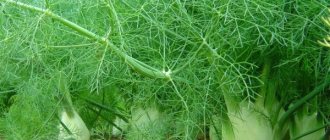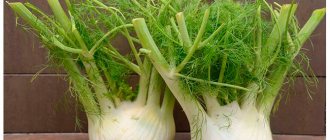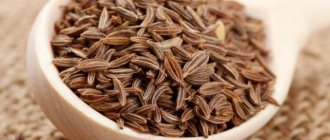Brief botanical information
Externally, fennel resembles dill because it has umbrellas characteristic of this culture. Based on this feature, the perennial plant is classified as a member of the Umbrella family. But it has a second name - pharmaceutical dill, which indicates the use of spicy vegetation in the production of medicines. There are two types of fennel found in nature:
- Common is the most common variety, characterized by a long, branched stem reaching up to 2 meters in height. The root of this type of plant is thick and shaped like a rod. The leaves are large, dark green in color.
- Italian fennel is a lesser known variety in our northern latitudes. This is a vegetable variety with a thick, fleshy stem.
The uniqueness of fennel (each of the listed species) is that all parts of the plant can be used for culinary purposes. Thus, the seeds of spicy plants are often used as a seasoning, and the leaves are used to decorate dishes.
The most productive part is considered to be the onion, from which you can prepare a delicious fennel salad or sauce. The bulbs can be pickled, baked, combined with vegetables and meat.
How to eat fennel
Seeds, herbs, and fennel roots are used in cooking.
Fennel is a perennial plant from the Apiaceae family, which looks like dill, and tastes and aroma resembles anise.
Although all parts of the plant are edible, recipes for cooking with fennel include the bulb. The onion is added as a vegetable to meat and vegetable dishes, marinated, and made into broths and sauces.
How to eat fennel:
- The stems and leaves are used as an aromatic herb, which gives dishes a refreshing and sweet taste and decorates salads.
- The seeds are dried and added as a seasoning for baking baked goods and some confectionery products, as well as for meat dishes.
In addition to its culinary benefits, fennel has beneficial medicinal properties. It has an expectorant and carminative effect, stimulates the intestines and activates the kidneys. Thanks to vitamins and flavonoids, the plant copes well with colds, flu and spring vitamin deficiency.
Features of the composition of the spicy product
The most valuable component of fennel is its essential oils. Their share in the product is incredibly high, but there are especially many essential components in the fruits. In addition to essential oil, the spicy plant contains:
- fatty oils (their content is especially high in the seeds of the plant;
- organic acids, including linoleic, oleic;
- mineral elements;
- complex of vitamins (PP, ascorbic acid, retinol, vitamin group “B”);
- carotenes;
- flavonoids.
Listed here are only the main active substances, which in percentage terms make up the majority of the composition of the plant product. But, in addition to these components, the spice contains complex chemical compounds, such as phytosterol. Scientists have proven that this substance can lower blood cholesterol.
Methods of use for medical purposes
There are several ways to use it for medical purposes.
- Decoction.
- Infusion.
- Essential oil (what is fennel oil, how to use and store it, read here).
- Compress.
- Steam.
- Enema.
Before using any product, it is better to consult your doctor! Don't self-medicate!
Beneficial features
Fennel, thanks to its balanced composition, is able to have a beneficial effect on the human body. Moreover, such a positive impact is not limited to changes in any particular system, but acts comprehensively. Let us list the main properties that the spice is endowed with in abundance:
- anti-inflammatory;
- expectorant;
- antibacterial;
- diuretic;
- antispasmodic;
- antioxidant;
- carminative.
In addition to these beneficial actions, as part of dishes it normalizes digestion, and also acts as a prophylactic against the formation of cholesterol plaques in blood vessels.
Fennel is also valued for its ability to freshen breath. For example, in India, it is customary for restaurants to bring fennel during the final serving of dishes.
How is it used in medicine?
Preparations created on the basis or using fennel are widely used in medicine and bring undoubted benefits to our body.
Different forms are used: tinctures, decoctions, powder, oil . Indications for use:
- Infusions are used to treat fungal diseases.
- Essential oil relieves digestive problems. The oil can be used in aroma lamps and pendants. This smell calms, reduces anxiety, improves mood.
- Crushed dry leaves are a good expectorant. Many natural cough remedies include fennel.
- The decoction is recommended for nursing mothers to improve lactation.
- A decoction of the seeds is instilled into the eyes for conjunctivitis.
- Many people know the name “dill water”, this is the same decoction. It helps get rid of colic and bloating.
You will find more details about the benefits and harms of fennel in a separate article.
Home cooking methods
To have a good quality spicy product at your disposal, you need to know how to prepare it. Unlike other spices, such a product is rarely seen in the store. Much in this matter depends on the taste preferences of a particular family, but most housewives use ground fennel in the preparation of meat dishes, soups and some types of confectionery. This seasoning is obtained from dried seeds by grinding with a coffee grinder.
If fresh leaves and stems are available, they can be used as an aromatic addition to dishes. Spicy herbs go especially well with vegetables. The spice gives salads a beautiful look and a slightly sweet taste. From fresh parts of the plant you can make preparations for the winter. Drying and pickling are suitable for this purpose.
The above-ground part of the plant, that is, the leaves and stem, is usually dried. The process sequence is as follows:
- First, you need to remove the limp and yellowed leaves and rinse them well under running water.
- A thin layer of fresh plant material is laid out on paper.
- It is recommended to dry fennel in a shaded place.
- The raw materials must be stirred periodically during the drying process.
- When the greens are dry, they are crushed, then the ground fennel is collected in a canvas bag. You can use cardboard containers with a hermetically sealed lid for storage.
Often, the traditional dry salting method is used for harvesting, which is used when preserving dill and parsley.
Since root vegetables are most commonly used in cooking, you need to have an idea of how to prepare them properly before including them in a dish. Primary culinary processing comes down to the following steps:
- First, the tubers are washed with water.
- Then dry with a towel.
- Then the bulb is cut into several slices and the core is removed.
- Leaves must be removed from the outside.
Fennel in the food industry
In European countries, this spice is used in the industrial canning of fish and the production of sausages.
The fruits and roots of the plant have long been used in baking bakery and some confectionery products. Ground fennel seeds serve as raw material for vegetable oil, which is used in confectionery production.
Fennel fruit powder is added to various drinks, teas, and syrups to improve their aroma. In addition, it is used to flavor alcohol.
What can you cook with spices?
It’s time to offer the most popular recipes for preparing fennel dishes that will diversify your daily diet and decorate your holiday table. By the way, dishes with fennel are given a special place in the national cuisine of many countries around the world. Spaniards and Italians add spice to baked goods and tea, and Slavs prefer to add spice to salads and main courses. Moreover, there are a lot of possible options for a harmonious combination of this spice with other products, so every creative housewife has a chance to create a new culinary miracle, because you can even cook any meat soup with fennel. Well, while work continues in this direction, let’s talk about how today fennel is used in cooking in different ways of preparing dishes.
Fennel sauce
It’s easy to prepare this dressing if you have:
- Garlic – 1 clove;
- Fennel – large head;
- Vermouth (dry) – 100 ml;
- Egg yolk;
- Butter – 50 g;
- Vegetable or fish broth – 150 ml;
- Heavy cream – 100 ml;
- Salt to taste.
Cooking sequence
- The main seasoning, that is, fennel, is finely chopped. The garlic needs to be chopped.
- Melt the butter in a deep frying pan, then add the fennel.
- Fry the vegetable product while stirring for 5 minutes.
- After this, broth and wine are poured into the container, and garlic must also be added.
- When the mixture boils, it is immediately removed from the heat.
- Now you need to beat the cream with the egg yolk. The resulting mass should be poured into the frying pan, which is again placed on low heat.
- The sauce should thicken. It is served hot, and the dressing can be garnished with green fennel leaves.
Salad with orange
As noted above, fennel does not conflict with vegetables and fruits, which allows it to be used quite freely for preparing cold dishes and snacks. For example, supporters of a healthy diet will definitely like the salad with fennel and orange. This food is especially useful during the period of colds and flu. And the ease of preparation will appeal to any housewife.
Required:
- Fennel bulb;
- Medium sized orange;
- 2 tbsp. spoons of olive oil;
- A bunch of parsley;
- Balsamic vinegar – 2 l. Art.
Preparation:
- The root vegetable should be cut into half rings, and the orange should be divided into slices.
- The juice should be collected separately in a glass, combined with vinegar, then added oil.
- First, orange and fennel are placed on a plate, the dish is salted and seasoned with the prepared sauce. The culinary masterpiece is decorated with fresh herbs on top.
The calorie content of this extremely healthy dish is only 121 kcal, which allows you to include it in your diet without fear of gaining extra pounds.
Vegetable stew
This dish also does not threaten weight gain, but the benefits from it will be enormous. The fact is that such a vegetable snack with a moderately spicy taste will charge you with energy for the whole day. The dish is prepared immediately before serving. To prepare it you need to prepare: zucchini, a couple of fennel tubers, carrots, 3 tomatoes, two potatoes, 3 sweet peppers, a clove of garlic, a tablespoon of olive oil. As always. Salt and herbs - optional.
Sequencing:
- Peeled and washed vegetables must first be cut into any shape, and fennel into cubes.
- The chopped spicy product is laid out in a frying pan, pepper and garlic are added.
- Then the fried fennel needs to be supplemented with the rest of the vegetables, salt the mixture, and simmer until all the components become soft.
- The chopped tomato should be added last.
- Immediately after removing from the stove, the finished vegetable stew should be placed on plates and garnished with herbs.
Combination with seasonings
Fennel root goes well with dry spices and fresh herbs in salads, casseroles, and soups. For salads, citrus juice, dried zest or whole orange slices are also used. Additionally, they add aromatic herbs such as tarragon, basil, arugula, and dill. In hot dishes with this vegetable use:
- paprika, turmeric;
- cardamom, cumin, herbs de Provence;
- cumin, bay leaf.
Due to the sweet taste of the product, spicy ingredients are often excluded from dishes. To add piquancy and emphasize the aroma, add:
- allspice or pink pepper;
- marjoram, dried garlic, black pepper.
Mustard seeds are used in vegetable marinades, where fennel stalks are added in addition to the root.
Harm and contraindications to fennel root
So, fennel root is a unique product that is very beneficial for humans.
It is noteworthy that it has virtually no contraindications. However, there is still a group of people who should not eat the plant; it includes: People suffering from epilepsy
. The ban in this case is explained by the content of the root of a substance called dopamine, which is harmless to a healthy person, but can cause an attack in people suffering from epilepsy.
Pregnant
. The plant also contains substances that can compete with estrogen, the female sex hormone. For an expectant mother, this state of affairs is undesirable.
. It is usually not difficult to determine an allergy to the root of the plant; slight dizziness and/or nausea is felt from just its smell.
There is also a group of people who should limit their consumption of the product, that is, they can eat it, but not often and in small quantities.
People who should limit their consumption of fennel root are:
- Suffering from diseases that may be accompanied by bleeding, such as hemorrhoids. The fact is that consuming the product in large quantities can cause bleeding.
With heart rhythm disturbances. In general, the plant has a beneficial effect on the cardiovascular system, however, in case of serious heart diseases, expressed in rhythm disturbances, it is better to limit the consumption of fennel root in food.
Doctors have not yet come to a consensus regarding the use of fennel root as food for women during lactation. On the one hand, the plant stimulates milk production, and tea from it is prescribed to newborns to combat colic. On the other hand, fennel root contains many biologically active substances, which can cause allergies in a small child. A sensible conclusion, in our opinion, is as follows: it is better for the mother to refuse fennel root, and for the baby to drink tea from the plant only as prescribed by a doctor in the indicated doses.
Interesting recipes with fennel
Vegetable soup with fennel
To prepare the dish you will need:
- fennel (petiolate) - 1-2 pcs.
- celery (root) – 100g
- leek – 100g
- carrots – 100g
- potatoes - 300g
- vegetable oil – 50ml
- salt to taste
Preparation:
Cut the well-washed leeks into small cubes, and the separated and washed fennel stalks into large pieces.
Turn the washed and peeled carrots and celery into thin long sticks. Saute all vegetables in vegetable oil for about 3 minutes.
Cut the washed and peeled potatoes into long pieces, pour boiling water over them and cook first for 5 minutes, and then, after adding the sautéed vegetables, for another 3 minutes. Add some salt.
The soup is served with sour cream or fresh cream. If desired, you can add freshly squeezed carrot juice and crushed nut kernels to it.
Composition and calorie content of fennel root
Every person needs to make fennel root part of their diet; this product is fraught with enormous benefits. It contains a wide range of vitamins, micro- and macroelements and other components necessary for the human body. In addition, this product is low-calorie, so it will only benefit those who are on a diet.
Calorie content of fennel root is 31 kcal per 100 g of product, of which:
- Proteins - 1.24 g;
- Fats - 0.2 g;
- Carbohydrates - 7.3 g;
- Dietary fiber - 3.1 g;
- Water - 90.21 g;
- Ash - 1.05 g.
Macroelements per 100 g:
- Potassium - 414 mg;
- Calcium - 49 mg;
- Magnesium - 17 mg;
- Sodium - 52 mg;
- Phosphorus - 50 mg.
Microelements per 100 g:
- Iron - 0.73 mg;
- Manganese - 0.191 mg;
- Copper - 66 mcg;
- Selenium - 0.7 mcg;
- Zinc - 0.2 mg.
Vitamins per 100 g:
- Vitamin A, RE - 7 mcg;
- Vitamin B1 - 0.01 mg;
- Vitamin B2 - 0.032 mg;
- Vitamin B5 - 0.232 mg;
- Vitamin B6 - 0.047 mg;
- Vitamin B9 - 27 mcg;
- Vitamin C - 12 mg;
- Vitamin RR, NE - 0.64 mg.
In addition to these components, fennel root contains beneficial essential oils, antioxidants, phytonutrients, as well as substances such as flavonoids, which have the ability to regulate metabolic processes in the human body.











